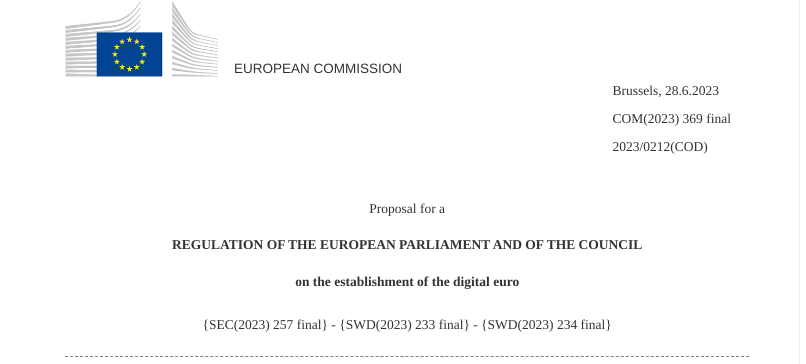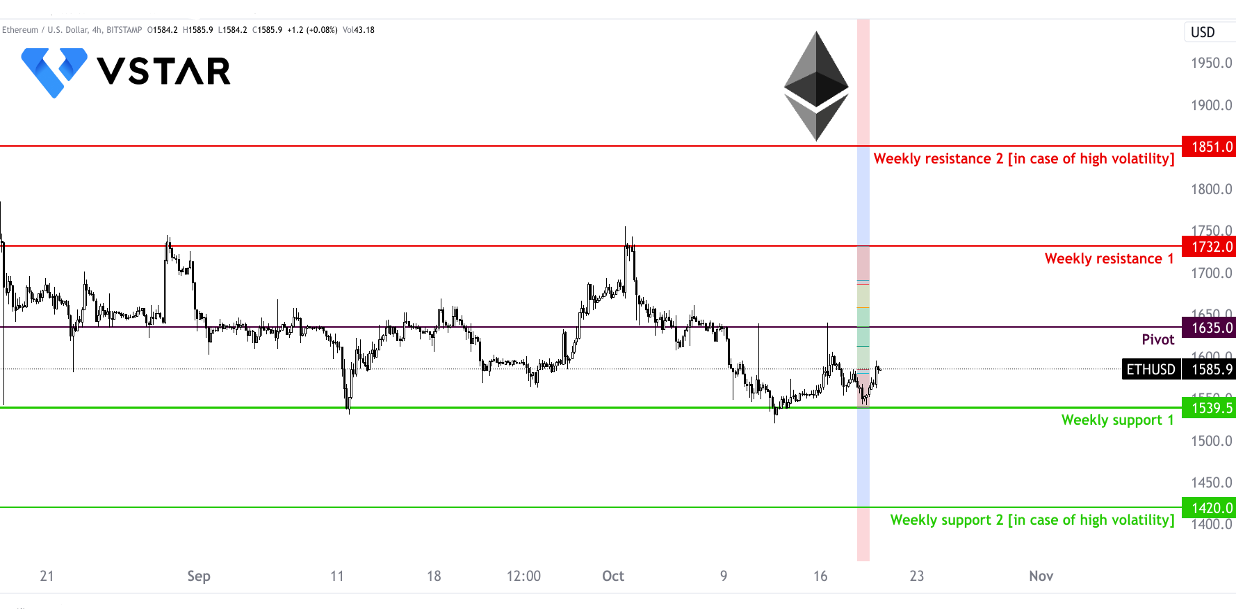- 數字歐元預計將成為日常交易中傳統歐元的政府支持的數字代表,使其有別於以太坊等加密貨幣。
- 歐元體系對監管合規性和數據保護的關注可能會推動歐洲現有的加密貨幣遵守類似的法規。
- 數字歐元可以作為一種更穩定、更受監管的替代品與現有加密貨幣(尤其是比特幣)競爭,並可能影響投資者轉移其持有的資產。
歐元系統決定進入數字歐元項目的準備階段,這標誌着數字貨幣發展的一個重要里程碑,並有可能從根本上影響加密貨幣市場的長期發展。

來源:ecb.europa.eu
對以太坊 (ETH) 的具體影響
數字歐元作為政府支持的數字貨幣,就其主要用例(即支持智能合約和去中心化應用程序(DApp))而言,可能無法與以太坊(與以太坊相關的區塊鏈平台)直接競爭。數字歐元更有可能作為日常交易中傳統歐元的數字代表。
此外,歐元體系對互操作性和跨境支付便利化的關注可能會間接使以太坊和以太坊受益。以太坊的多功能性和廣泛採用可能使其成為開發與數字歐元互動的解決方案的有吸引力的平台。這可能會導致對以太幣支付汽油費的需求增加,這是在以太坊網絡上執行交易和智能合約所必需的。
最後,以太坊生態系統的增長和發展,包括 DeFi(去中心化金融)項目和 NFT(不可替代代幣)平台,可能會繼續推動對以太幣的需求。歐元體系的項目可能不會對充滿活力且快速發展的 DeFi 和 NFT 行業產生直接影響。
監管環境
數字歐元對加密貨幣影響最關鍵的方面之一是監管環境。歐元體系對監管合規性和數據保護的承諾為數字貨幣設定了高標準。這可能會對現有的加密貨幣(尤其是在歐洲運營的加密貨幣)施加壓力,要求其遵守類似的法規。在許多情況下,這需要遵守反洗錢 (AML) 和了解你的客戶 (KYC) 法規等。加密貨幣項目需要證明對數據隱私和用戶保護的承諾,這可能會導致行業達到一定程度的標準化。不遵守這些標準可能會導致法律挑戰、監管行動,甚至在某些司法管轄區被禁止。因此,數字歐元對監管和數據保護的關注可能有助於建立一個更加嚴格和統一監管的加密貨幣市場。
競爭和採用
數字歐元作為央行支持的數字貨幣,可能會對現有的加密貨幣構成重大挑戰。它可能被認為是一種更穩定、更受監管的替代方案,特別是對於尋求可靠的交換媒介和價值存儲的個人和企業而言。雖然像比特幣這樣的加密貨幣作為數字黃金或對沖通脹的工具而受到歡迎,但數字歐元可以直接與這種說法競爭。如果數字歐元被證明是一種值得信賴且被廣泛接受的數字貨幣,一些投資者可能會將其持有的加密貨幣轉向數字歐元,特別是對於日常交易。
競爭可能會擴展到穩定幣,例如 Tether (USDT) 或 USD Coin (USDC),它們通常用於加密貨幣領域的快速且低成本的交易。用於此類目的的數字歐元的可用性可能會減少對現有穩定幣的需求。
隱私和數據保護
隱私是許多加密貨幣用戶最關心的問題。歐元體系對數據保護和隱私的重視可能會引起尋求安全和私密數字支付解決方案的個人和企業的共鳴。數字歐元旨在確保高水平的隱私,歐元系統無法查看用戶的個人數據或將支付信息與個人聯繫起來。它甚至承諾為離線支付提供類似現金的隱私級別。
相比之下,像比特幣這樣的加密貨幣是假名的,這意味着交易記錄在公共分類賬上,理論上可以追蹤資金流向。這種隱私功能的差異可能會影響用戶在匿名性至關重要的某些類型的交易中青睞數字歐元。
普惠金融
數字歐元最引人注目的方面之一是其對可訪問性的承諾,包括對於那些無法使用傳統銀行服務或數字設備的人。在許多地區,特別是在發展中國家,普惠金融仍然是一項重大挑戰。數字歐元可以提供一個可行的解決方案,讓沒有銀行賬戶或智能手機的個人參與數字經濟。
這可能會導致偏好發生轉變,特別是在金融基礎設施有限的地區。數字歐元可能成為進行交易、領取工資和獲得金融服務的有吸引力的選擇,從而有可能減少對現金或傳統銀行賬戶的依賴。加密貨幣需要適應這種不斷變化的格局,才能在金融包容性成為關鍵問題的地區保持競爭力。
市場碎片化和互操作性
廣泛接受的數字歐元的存在可能有助於減少加密貨幣領域的市場碎片化。目前,有數千種加密貨幣和代幣,每種都有其用例、技術基礎設施和用戶群。數字歐元可以鼓勵傳統金融系統和加密貨幣之間的互操作性和集成。
加密貨幣項目和平台可能會尋求與數字歐元整合的方法,以利用更大的用戶群。這可能會導致與數字貨幣交互的協議和接口更加標準化,從而可能簡化加密貨幣用戶體驗。此外,歐元體系對互操作性的重視可能會擴展到跨境交易,使用戶更容易在數字歐元和其他數字資產(包括加密貨幣)之間轉移資金。
經濟穩定和資產多元化
數字歐元可能會吸引那些優先考慮金融資產穩定性的用戶。雖然加密貨幣已被公認為投機資產和對沖通脹的工具,但它們也因其波動性而聞名。數字歐元作為政府支持的數字貨幣,可以提供更穩定的價值儲存手段,特別是在經濟不穩定的地區。
一些投資者可能會選擇將數字歐元與加密貨幣一起納入投資組合,以實現資產多元化。通過這種方式,數字歐元可以在傳統法定貨幣的穩定性和加密貨幣的增長潛力之間起到平衡作用。這種多元化可能對規避風險的個人和機構投資者特別有吸引力。
央行數字貨幣 (CBDC) 勢頭
歐元體系在數字歐元項目上的進展可能會激勵其他央行加快自己的 CBDC 舉措。 CBDC 的全球採用可能會重新定義加密貨幣市場的動態。隨着越來越多的中央銀行開發數字貨幣,這些 CBDC 可能會相互互動,從而有可能為跨境數字支付和匯款的新時代鋪平道路。
各種 CBDC 及其各自的區塊鏈網絡之間的協作和互操作性可能會導致傳統支付系統的轉變,並進一步擾亂金融業。這種情況將鼓勵跨境支付的創新,而加密貨幣可能需要不斷發展才能在這種新環境中保持競爭力。
對比特幣和加密貨幣估值的影響
比特幣通常被視為數字黃金,可能是受影響最直接的加密貨幣之一。投資者紛紛湧向比特幣,尋求價值儲存以及對沖通脹和經濟不穩定的工具。數字歐元(一種政府支持的數字貨幣,非常強調穩定性)的推出可能會改變圍繞比特幣的敘述。
投資者可能會重新評估他們的投資組合,從比特幣轉向多元化,將數字歐元作為更穩定的替代品。雖然比特幣的稀缺性和獨特的價值主張仍然可以吸引長期投資者,但來自數字歐元的競爭可能會導致比特幣估值波動性加大。
其他加密貨幣,尤其是那些依賴隱私功能的加密貨幣,面對數字歐元增強的隱私保護,也可能面臨挑戰。為特定用例(例如智能合約)設計的加密貨幣可能會經歷較少的直接競爭,但仍可能受到數字貨幣格局更廣泛變化的影響。
總而言之,歐元體系的數字歐元項目有可能從根本上重塑加密貨幣市場。它對監管合規性、數據保護、隱私和可訪問性的重視可能會影響加密貨幣生態系統內的採用、監管和用戶偏好,特別是在歐元區。然而,長期影響將取決於數字歐元的成功開發和採用,以及其他央行和加密貨幣行業對這一變革性發展的反應。數字歐元的旅程可能會受到加密貨幣愛好者和傳統金融機構的密切關注,因為它正在成為傳統法定貨幣的潛在數字替代品。
ETH/USD 每周價格走勢的技術視角可以理解如下:

來源:tradingview.com




















